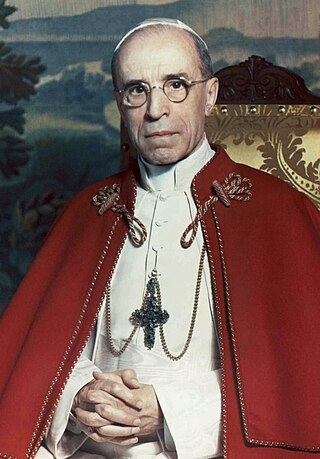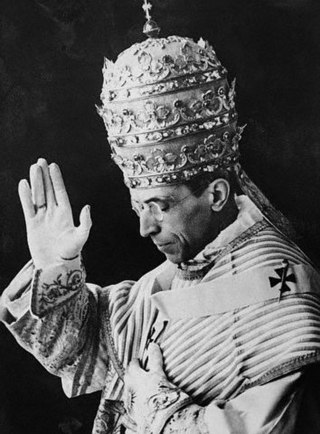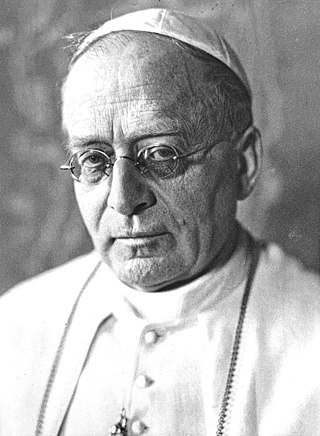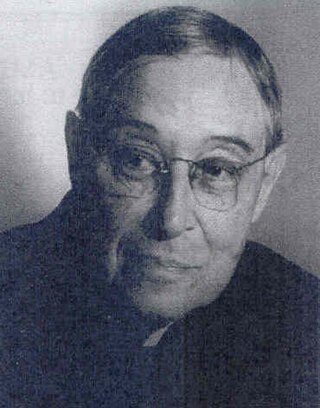Related Research Articles

Pope Pius XII was head of the Catholic Church and sovereign of the Vatican City State from 2 March 1939 until his death in October 1958. Before his election to the papacy, he served as secretary of the Department of Extraordinary Ecclesiastical Affairs, papal nuncio to Germany, and Cardinal Secretary of State, in which capacity he worked to conclude treaties with various European and Latin American nations, including the Reichskonkordat treaty with the German Reich.

Pope Pius XI, born Ambrogio Damiano Achille Ratti, was the Bishop of Rome and supreme pontiff of the Catholic Church from 6 February 1922 to 10 February 1939. He also became the first sovereign of Vatican City upon its creation as an independent state on 11 February 1929 where he held that position in addition to being the earthly leader of the Catholic Church until his death in February 1939. He assumed as his papal motto "Pax Christi in Regno Christi", translated "The Peace of Christ in the Kingdom of Christ".
Mystici Corporis Christi(The Mystical Body of Christ) is an encyclical issued by Pope Pius XII on 29 June 1943 during World War II. Its main topic is the Catholic Church as the Mystical Body of Christ.
Humani generis is a papal encyclical that Pope Pius XII promulgated on 12 August 1950 "concerning some false opinions threatening to undermine the foundations of Catholic Doctrine". It primarily discussed, the encyclical says, "new opinions" which may "originate from a reprehensible desire of novelty" and their consequences on the Church.

Summi Pontificatus is an encyclical of Pope Pius XII published on 20 October 1939. The encyclical is subtitled "on the unity of human society". It was the first encyclical of Pius XII and was seen as setting "a tone" for his papacy. It criticizes alleged major errors of the time, such as ideologies of racism, cultural superiority and the totalitarian state. It also sets the theological framework for future encyclical letters such as Mystici corporis Christi (1943). The encyclical laments the destruction of Poland, denounces the Molotov–Ribbentrop Pact, and calls for a restoration of independent Poland.
Generis may refer to:
Unitas may refer to:

The theology of Pope Pius XII is reflected in his forty-one encyclicals, as well as speeches and nearly 1000 messages, during his almost 20-year pontificate. The encyclicals Mystici corporis and Mediator Dei advanced the understanding of membership and participation in the Catholic Church. The encyclical Divino afflante Spiritu began opening the door to historical-critical biblical studies. But his magisterium was far larger and is difficult to summarize. In numerous speeches Catholic teaching is related to various aspects of life, education, medicine, politics, war and peace, the life of saints, Mary, the mother of God, things eternal and temporal.
Humani may refer to :

The relations between Pope Pius XI and Judaism during his reign from 1922 to 1939 are generally regarded as good. The pontiff was particularly opposed to antisemitism, an important issue at the time when Nazi Germany was rising. Certain favourable opinions of Pius XI were subsequently used to attack the perceived silence of Pope Pius XII.

The papacy of Pius XII began on 2 March 1939 and continued to 9 October 1958, covering the period of the Second World War and the Holocaust, during which millions of Jews were murdered by Adolf Hitler's Germany. Before becoming pope, Cardinal Pacelli served as a Vatican diplomat in Germany and as Vatican Secretary of State under Pius XI. His role during the Nazi period has been closely scrutinised and criticised. His supporters argue that Pius employed diplomacy to aid the victims of the Nazis during the war and, through directing his Church to provide discreet aid to Jews and others, saved hundreds of thousands of lives. Pius maintained links to the German Resistance, and shared intelligence with the Allies. His strongest public condemnation of genocide was, however, considered inadequate by the Allied Powers, while the Nazis viewed him as an Allied sympathizer who had dishonoured his policy of Vatican neutrality.
Pope Pius XII's 1942 Christmas address was a speech delivered by Pope Pius XII over Vatican Radio on Christmas 1942. It is notable for its denunciation of the extermination of people on the basis of race, and followed the commencement of the Nazi Final Solution program to exterminate the Jews of Europe. The significance of the denunciation is a matter of scholarly debate.

Vatican City pursued a policy of neutrality during World War II, under the leadership of Pope Pius XII. Although the city of Rome was occupied by Germany from September 1943 and the Allies from June 1944, Vatican City itself was not occupied. The Vatican organised extensive humanitarian aid throughout the duration of the conflict.

During the pontificate of Pope Pius XI (1922–1939), the Weimar Republic transitioned into Nazi Germany. In 1933, the ailing President von Hindenburg appointed Adolf Hitler as Chancellor of Germany in a Coalition Cabinet, and the Holy See concluded the Reich concordat treaty with the still nominally functioning Weimar state later that year. Hoping to secure the rights of the Church in Germany, the Church agreed to a requirement that clergy cease to participate in politics. The Hitler regime routinely violated the treaty, and launched a persecution of the Catholic Church in Germany.
Yad Vashem, the state of Israel's official Holocaust memorial, has generally been critical of Pope Pius XII, the pope during The Holocaust. For decades, Pius XII has been nominated unsuccessfully for recognition as Righteous Among the Nations, an honor Yad Vashem confers on non-Jews who saved Jewish lives during the Holocaust altruistically and at risk to their own lives.
The public statements of Pope Pius XII on the Holocaust, or lack thereof, are one of the most controversial elements of the historical debate about Pope Pius XII and the Holocaust. Pius XII's statements have been scrutinized as much, if not more, than his actions during the same period. Pius XII's statements, both public and private, are quite well documented in the Vatican Secret Archives; eleven volumes of documents from his papacy were published between 1965 and 1981 in Actes et documents du Saint Siège relatifs à la Seconde Guerre Mondiale.

John LaFarge Jr. was an American Jesuit Catholic priest known for his activism against racism and anti-semitism. Involved in the heyday of Thomas Wyatt Turner's Federated Colored Catholics. LaFarge founded an offshoot, the Catholic Interracial Council in New York City. Branches also grew in Philadelphia and Chicago. In the run-up to World War II, he worked on a draft of a papal encyclical against racist and totalitarian ideologies for Pope Pius XI; entitled Humani generis unitas, though it was never promulgated due to the death of Pius XI on February 10, 1939.

Catholic resistance to Nazi Germany was a component of German resistance to Nazism and of Resistance during World War II. The role of the Catholic Church during the Nazi years remains a matter of much contention. From the outset of Nazi rule in 1933, issues emerged which brought the church into conflict with the regime and persecution of the church led Pope Pius XI to denounce the policies of the Nazi Government in the 1937 papal encyclical Mit brennender Sorge. His successor Pius XII faced the war years and provided intelligence to the Allies. Catholics fought on both sides in World War II and neither the Catholic nor Protestant churches as institutions were prepared to openly oppose the Nazi State.
During the Holocaust, the Catholic Church played a role in the rescue of hundreds of thousands of Jews from being murdered by the Nazis. Members of the Church, through lobbying of Axis officials, provision of false documents, and the hiding of people in monasteries, convents, schools, among families and the institutions of the Vatican itself, saved hundreds of thousands of Jews. The Israeli diplomat and historian Pinchas Lapide estimated the figure at between 700,000 and 860,000, although the figure is contested.
References
- Passelecq, Georges; Suchecky, Bernard. L’Encyclique Cachée de Pie XI: Une occasion manqué de l’Église face a l’antisemitisme. Editions La Decouverte, Paris 1995. (engl) The Hidden Encyclical of Pius XI Harcourt, Brace, and Co., 1997.
- Encyclical Summi Pontificatus on the Vatican website